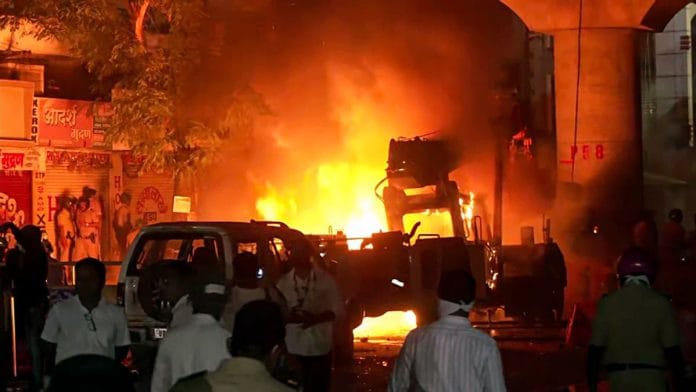If it were possible, 348 years after his death, Aurangzeb would turn in his grave. In his name, parts of Nagpur witnessed communal riots on Monday evening, stoked by politicians and right-wing groups, then fanned by social media rumours and reported mobilisation by local Muslim leaders.
And then, there’s the sensational coverage by television news channels, which only made a bad situation worse.
On Monday night and throughout Tuesday, news channels shrieked that Hindus were in danger, that their homes were being targeted by Muslims. They repeatedly aired close-up footage of rioters, so that their religion could be clearly identified. They even numbered each man—just as they had done during the 2022 Jahangirpuri riots in Delhi and the 2024 Sandeshkhali violence in West Bengal.
In doing so, they were not just reporting the “truth” of the communal clashes, as Times Now Navbharat claimed; they were amplifying, magnifying, and aggravating a volatile situation.
The media’s duty is to report incidents and identify those involved in violence. However, this can be done without sensationalism—without mentioning Aurangzeb’s name in every headline or branding the rioters as ‘Aurangzeb’s gang’ (Republic Bharat).
Rewind to the Maha Kumbh stampede of 29 January. Details of the incident, including the number of deaths, injuries and missing persons, were downplayed by both authorities and television news channels, which instead focused on calming fears and preventing panic.
In Nagpur’s communal crisis, they did the opposite.
On Wednesday, channels such as Times Now, India Today, and CNN News 18 not only reported on the FIR in the ‘Maha Aurangzeb War’ (India Today) and the arrest of the alleged “mastermind” (Times Now, India Today), Faheem Shamim Khan, but also replayed visuals of vandalism and Muslims shouting slogans “praising Aurangzeb” (India Today). They also highlighted claims of a female police officer being “sexually assaulted” by the rioters (Times Now).
This kind of coverage is likely to deepen communal divisions rather than foster the “positive atmosphere” called for by Union Minister Nitin Gadkari.
Also read: Live Maha Kumb coverage, govt’s PR blitz—after stampede, misinformation trivialised failure
Build-up to Nagpur riots over Aurangzeb
Nagpur’s communal violence was no surprise—it was waiting to happen since early March, fuelled by comments and incidents that news channels eagerly magnified.
TV news gave undue importance to provocative statements from politicians, including Maharashtra Chief Minister Devendra Fadnavis, Deputy Chief Minister Eknath Shinde, and Samajwadi Party’s Abu Azmi. Newspapers also reported these remarks but without the theatrics.
For example, Fadnavis’s support for removing Aurangzeb’s grave and his dismay over the state government having to protect the site were repeatedly highlighted on TV.
Similarly, Shinde’s remarks that those who praise Aurangzeb are “traitors” was all over the news.
So too Abu Azmi’s defense of Aurangzeb, arguing that he was wrongfully demonised in the film Chhaava and was not a “cruel administrator”.
Throughout March, news channels prominently displayed statements and covered protests by the Bajrang Dal and Vishwa Hindu Parishad, both of which demanded Aurangzeb’s grave be removed from Chhatrapati Sambhajinagar in Maharashtra.
On 17 March, TV news aired live coverage of Bajrang Dal and VHP protests in Nagpur and other parts of Maharashtra in support of their demand, showing effigy burnings and people stomping on a photograph.
By Tuesday, the airwaves were filled with footage of smoke, fires, and stone-pelting. These were accompanied by their fondness for colourful headlines: ‘Embers of hatred” (NDTV India), ‘Religious hatred in Nagpur’ (India News), ‘Rumours burn Nagpur’ (Aaj Tak), ‘Pre-planned riots target Hindus’ (Zee News), ‘Who is provoking Muslims?’ (Republic Bharat), ‘Aurangzeb, Afwah, pre-planned attacks’ (CNN News 18).
The commentary was equally colourful — “They (rioters)…were carrying swords from Aurangzeb’s time, shouting ‘Allahu Akbar’ and hurling abuses…’ (Times Now Navbharat), “Eulogising Aurangzeb—is it justified?’ (CNN News 18), ‘Attacks on Hindu homes with the aim to cause communal trouble across the country’ (Republic Bharat).
News anchors repeatedly drew their viewers’ attention to the Muslim identity of the protesters and their “chilling” actions (India Today). They called the attackers “outsiders” and dwelt on the “afhwah ki aag” (Aaj Tak).
Also read: 12 hours after Maha Kumbh stampede, TV news back to ‘unshakeable faith, excellent arrangement’
Bajrang Dal-VHP role
Some efforts were made to recognise the role of Bajrang Dal and VHP in the build-up to the riots. Several channels mentioned their protests and effigy burnings. They also raised the tardy police response and intelligence failure (News 18 India, NDTV India).
A few anchors questioned the timing of the Bajrang Dal-VHP agitation and the necessity of their demands (Anand Narasimhan, CNN News 18). Others like ABP News’s Pratima Mishra asked, “What will be achieved by removing Aurangzeb’s grave? Will poverty end? Will history change?”
ABP’s Sandeep Chaudhary made a similar point, contrasting the Aurangzeb controversy with economic distress and farmer suicides in Maharashtra.
Preeti Chowdhury (India Today) reminded viewers that even Ravana has worshippers—“Where does the buck stop? Should we have riots in Aurangzeb’s name?”
These arguments were countered by anchors like Navika Kumar (Times Now), who argued—and presented what she claimed to be “evidence”—that the riots were pre-planned by Muslims and specifically targeted one community: Hindus. Republic TV’s Arnab Goswami went on about the “Muslim mob” and warned that “Muslims were being provoked everywhere.”
So, we got viewpoints from both sides, which in itself is unusual.
Let’s leave the last word to Hindustan Times. In its editorial ‘Much Ado About a Mughal Rule’, it wrote: “…it is a shortsighted ploy to do politics over the grave of a man who died centuries ago, to revive the fault lines that are best left untouched.”
The author tweets @shailajabajpai. Views are personal.
(Edited by Prashant)







Those images would also have been seen by international delegates to the Raisina Dialogue. A little jarring for what the conference sought to project as India’s image on the global stage.